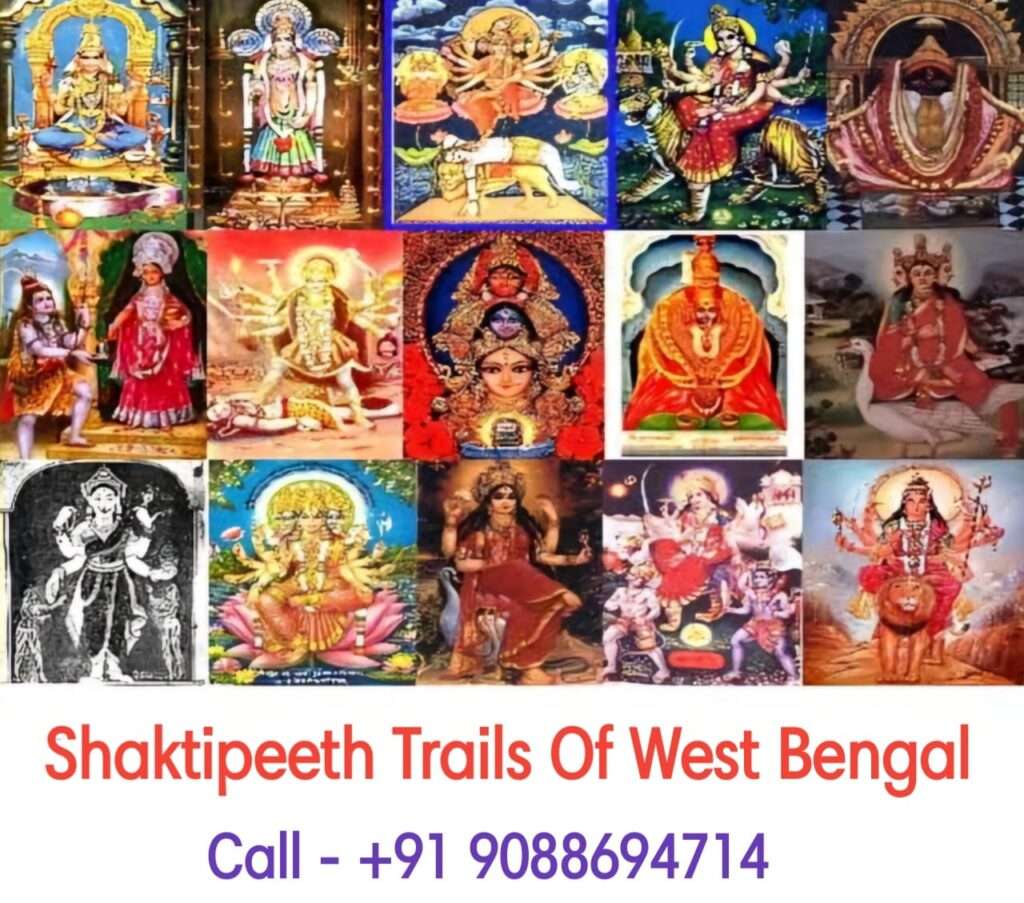West Bengal Shakti Peeth Tour Package – Shaktipeeth Tour from Kolkata
West Bengal Shakti Peeth Tour, Shakti Peethas are sacred sites in Hinduism, drawing devotees of the Shaktas sect and those who venerate Adi Shakti. During Ashwin and Chaitra Navaratri, pilgrims flock to these revered shrines across India to seek blessings from Devi Durga. West Bengal hosts grand Durga Puja celebrations, with Kolkata being a must-visit during Navaratri. Indian Railways offers enchanting train journeys to experience this auspicious time.Shakti represents various goddess manifestations like Dakshayani, Sati, Parvati, or Durga, symbolizing power in Hinduism. West Bengal Pilgrimage Tours,Legend has it that Shakti Peethas emerged from parts of Sati’s body when Lord Vishnu’s Sudarshana Chakra severed her corpse. There are 51 Shakti Peethas, including four Adi Shaktipeethas.The legend of Shakti Peethas revolves around Lord Brahma’s yajna to please Shakti and Shiva. Unhappy with Sati’s marriage to Shiva, Daksha insulted her, leading to her self-immolation. Shiva’s grief led to destructive acts until Vishnu intervened, causing Sati’s body parts to scatter, creating the Shakti Peethas. west bengal shaktipeeth tour package. पश्चिम बंगाल शक्तिपीठ यात्रा पैकेज
Top 13 Shakti Peeth/Sati Peeth Tour in West Bengal
| PLACE | DISTRICT IN WEST BENGAL | BODY PART OR ORNAMENT | SHAKTI | BHAIRAVA |
| Attahas – In Village Of Dakshindihi,Labhpur, In The District Of Birbhum | Dist – Birbhum West Bengal India | Lips | Phullara | Vishvesh |
| Bahula – On The Banks Of Ajay River At Ketugram, 8 Km From Katwa , Burdwan | Dist – Burdwan West Bengal India | Left Arm | Goddess Bahula | Bhiruk |
| Bakreshwar – On The Banks Of Paaphara River, 24 Km Distance From Siuri Town, District Birbhum , 7 Km From Dubrajpur Rly Station | Dist – Birbhum West Bengal India | Portion Between The Eyebrows | Mahishmardini | Bakranath |
| Kalighat – Kalipeeth , Kolkata | Dist – Kolkata West Bengal India | Right Toes | Kalika | Nakuleshwar |
| Kankalitala – On The Banks Of Kopai River 10 Km North-East Of Bolpur Station In Birbhum District, Devi Locally Known As Kankaleshwari | Dist – Birbhum West Bengal India | Bone / Skeleton | Devgarbha | Ruru |
| Kireeteswar – At Kireetkona Village, 3 Km From Lalbag Court Road Station Under District Murshidabad | Dist – Murshidabad West Bengal India | Crown | Vimla | Sanwart |
| Ratnavali – Locally Known As Anandamayee Temple. On The Banks Of Ratnakar River At Khanakul-Krishnanagar , District Hooghly | Dist – Hooghly West Bengal India | Right Shoulder | Kumari | Shiva |
| Trisrota – Locally Known As Bhramari Devi. In Jalpaiguri Near A Small Village Boda On The Bank Of River Teesta Or Tri-Shrota (Combination Of Three Flows) Mentioned In Puranas | Dist – Jalpaiguri West Bengal Indial | Left Leg | Bhraamari | Ambar |
| Sainthia – Locally Known As Nandikeshwari Temple. Only 1.5 Km From The Railway Station Under A Banyan Tree Within A Boundary Wall, Birbhum District | Dist – Birbhum West Bengal Indial | Necklace | Nandini | Nandikeshwar |
| Ujaani – 16 Km From Gushkara Station Under Burdwan District. Locally Known As Maa Manga Chandi Temple | Dist – Burdwan West Bengal Indial | Right Wrist | Mangal Chandika | Kapilambar |
| Vibhash – At Tamluk Under District Purba Medinipur | Dist – Midnapore West Bengal Indial | Left Ankle | Kapalini (Bhimarupa) | Sarvanand |
| Jogaadya – At Khirgram Under Burdwan District | Dist – Burdwan West Bengal India | Great Toe | Jugaadya | Ksheer Khandak |
| Nalhati – Known As ” Nalateshwari Temple “. From Nalhati Station Of Birbhum District . | Dist – Birbhum West Bengal India | Throat | Kalika Devi | Yogesh |
Shaktipeeth darshan | West Bengal Shaktipeeth Tour Packages

West Bengal Shakti Peeth Tour Package – West Bengal Shakti Peeth tour
In Hindu mythology, SHIVA represents consciousness, embodying the masculine principle, while SHAKTI embodies the feminine principle, symbolizing the activating power and energy. Īshwara signifies the omnipresent, eternal, formless divine principle; Purusha is the Ātmā, and Prakriti manifests as nature. In Hinduism, Purusha symbolizes consciousness, while Prakriti, the Feminine aspect, represents nature. Prakrati is omnipresent and embodies Shakti, the greatest creative force in the universe. SHAKTI encompasses energy, power, movement, change, and nature. It serves as the maternal principle, providing sustenance and vitality. The reverence and worship of Shakti, in its various manifestations, are widespread among Hindus globally, with numerous festivals celebrating its power.She is known as Durga, Chamunda, and Kali.Among the 51 Shaktipeeths in India, Shakti Peeth Pilgrimage Package, West Bengal boasts the highest number, with 13 Shaktipeeths. At Ryask Tourism, we are honored to organize special Shaktipeeth Tours for both individuals and groups, embracing the profound significance of these sacred sites.West Bengal Religious Tour Packages
West Bengal Shaktipeeth 4 Night 5 Days
Day wise Itinerary Tour West Bengal Shaktipeeth 4 Night 5 Days
Day 01: Devi Shakti Peeth in West Bengal, Arrived Kolkata Airport / Rly. Station – check in Hotel – Shaktipeeth Temple Visit ,Meet on arrival at Airport / Railway Station, visit (1) Kalighat Temple Shaktipeeth – at Kolkata & after that transfer to hotel. Check-in to hotel & after freshen up proceed for (2) ( travel time 2 hrs ) Vibhash Shaktipeeth – which is at Tamluk (Under District Midnapore), back to hotel at Kolkata.( – travel time 4 hrs) Overnight stay at Kolkata.
Day 02: Kolkata – Shaktipeeth Temple Visit – Shantiniketan Stay Early morning after breakfast check out from hotel at Kolkata & visit) (3) ( travel time 2 hrs ) Ratnavali Shaktipeeth – which is at Hoogly District, after that visit (4) ( travel time 2 hrs) Jogaadaya Shaktipeeth – which is at Burdwan District, after that visit (5) Ujaani Shaktipeeth – at Burdwan District and (6) Bahula Shaktipeeth – at Burdwan District. After that transfer to Shantiniketan ( travel time 2 hrs ). Overnight stay at Shantiniketan.
Day 03: Shantiniketan – Shaktipeeth Temple Visit – Tarapith Stay Early morning after breakfast check out from hotel at Shantiniketan & visit (7) ( travel time 1hrs) Kankalitala Shaktipeeth – which is at Birbhum District, after that visit (8) Attahas Shaktipeeth – which is at Birbhum District, after that visit (9) Bakreswar Shaktipeeth – at Birbhum District and (10) Sainthia Shaktipeeth – at Birbhum District. After that transfer to Tarapith ( travel time 2 hrs ). Overnight stay at Tarapith.
Day 04: Tarapith – Shaktipeeth Temple Kolkata Early morning after breakfast check out from hotel at Tarapith & visit (11) Nalateshwari Temple Shaktipeeth – Night halt in Kolkata
Day 05: Kolkata Local Sightseeing – Drop at Airport Post breakfast visit Dakshineshwar Kali Temple , Belur Mutt , Shopping and drop at Kolkata Airport by evening for onward journey.end of West Bengal Hindu Pilgrimage Trip.
West Bengal Shaktipeeth 3 Night 4 Days
Day wise Itinerary Tour West Bengal Shaktipeeth 3 Night 4 Days
DAY 01: West Bengal Shakti Peeth Yatra start from Fullara Devi Temple, Attahas – Kankalitala Temple – Tarapith TempleStart the tour by visiting the Shaktipeeth is located only 3kms from Labpur railway station (LBP), district Birbhum. Then visit the Kankalitala temple near Fullara. Later, visit the Tarapith Temple. Tarapith is a developing town near Rampurhat in Birbhum district of West Bengal. Overnight stay at hotel.
DAY 02: Bakreshwar Devi Temple – Nandikeshwari TempleAfter breakfast, visit the two temples and enjoy the essence of a pilgrimage tour.
DAY 03: Kalighat Temple – Kiriteshwari TempleVisit the Kalighat Temple located in the capital of West Bengal, Kolkata. It is one of the most famous temples of Kolkata. Later, visit the Kiriteshwari Temple. Near the banks of Hoogly river, there is a city named Azimganj. From Azimganj, the temple is about 10 km. Overnight stay in hotel.
DAY 04: Vibhas Shaktipeeth – Bhramari DeviStart the day by visiting the Vibhas Shaktipeeth situated in Tamluk town of District Purba Medinipur. Later, visit the Bhramari Devi (Jalpaiguri) situated near the border of Bangladesh and Sikkim. Though it is officially a part of West Bengal but its traditional culture matches with Sikkim and Bangladesh. Proceed on onward journey, Eastern India Pilgrimage Tour ends.
Inclusions
- AC Vehicle
- AC Rooms (For 3 Nights) on Family Basis in Budget Rooms
- Toll Taxes, Parking & Driver Batta.
- Tour Manager / Escort Charges
- 3 No. Breakfast ONLY
Exclusions
- Any expense of personal nature
- Any other expenses that is not mentioned in inclusions
- Rickshaw / Van charges wherever availed
- Tips to drivers
- Expenses and Entry fees at temples
CONTACT US
